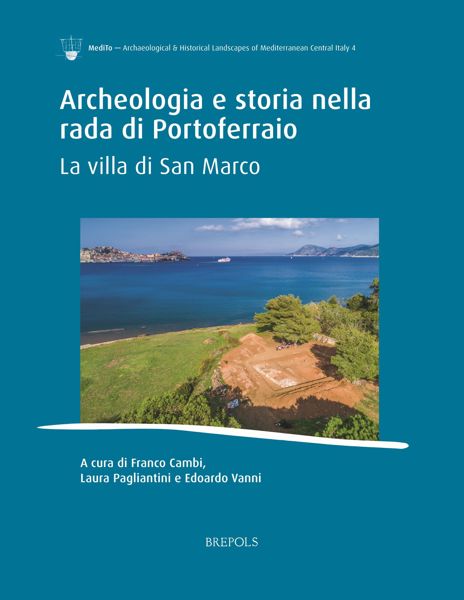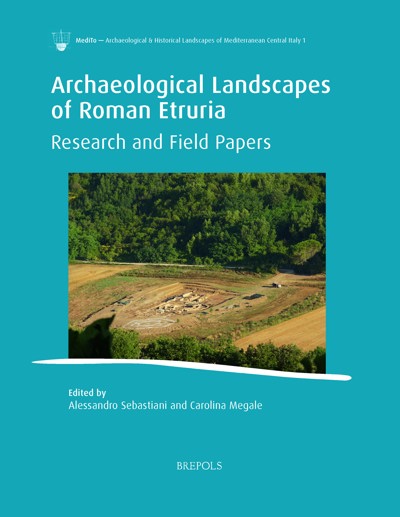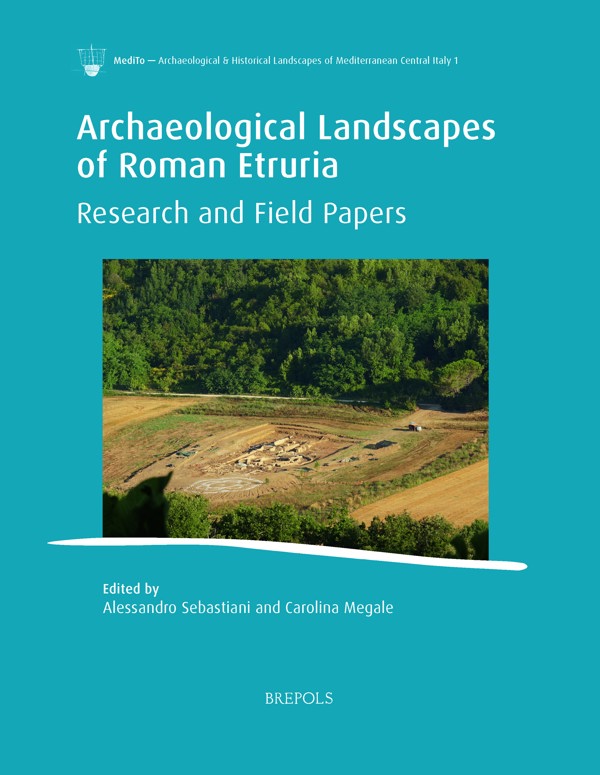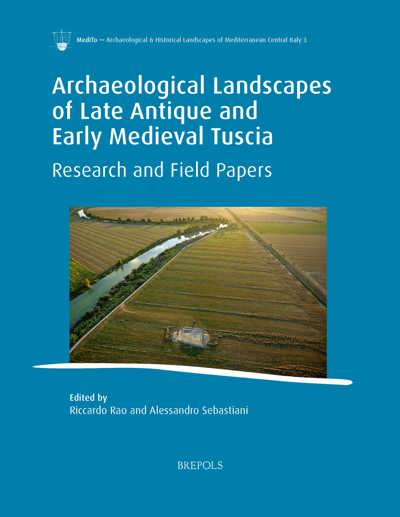
Archaeological Landscapes of Roman Etruria
Research and Field Papers
Alessandro Sebastiani, Carolina Megale (eds)
- Pages: 296 p.
- Size:216 x 280 mm
- Illustrations:95 b/w, 21 col., 3 tables b/w.
- Language(s):English
- Publication Year:2021
- € 115,00 EXCL. VAT RETAIL PRICE
- ISBN: 978-2-503-59139-1
- Paperback
- Available
- € 115,00 EXCL. VAT RETAIL PRICE
- ISBN: 978-2-503-59140-7
- E-book
- Available
This volume offers a fresh and dynamic new approach to our understanding of central-southern maritime Tuscany during the Roman period.
« Par la richesse et la diversité de ses contributions, ainsi que par la qualité de la documentation qu’il rassemble, cet ouvrage vient donc opportunément pallier une lacune manifestement importante, tout en évitant la dispersion de travaux relatifs à une même aire géographique. » (Vincent Jolivet, dans Histara, 15/09/2022)
“Archaeological landscapes of Roman Etruria is a volume with broad appeal that, in the editors’ own words, offers the chance to “glimpse a fragmented rural landscape which embraced its local peculiarities even as it remained engaged with an increasingly globalized world” (p. 20). In particular, all 18 chapters speak to the central theme of how historical landscapes can be viewed as containers, or canvases, for emergent political, economic and social contexts —a theme also deftly highlighted by our next volume.” (Claire Nesbitt, in Antiquity, 96, 2022, p. 1358)
“This is a welcome presentation of research by mainly Italian, or Italian-born researchers working in other countries to a wider international audience. It emphasises the importance of long-term and chronologically wide-ranging study of fascinating landscapes and presents the less discussed areas of Rusellae, Vetulonia and Vada Volaterrana with regard to what is known of their natural landscape. It leaves the reader eager for the final report of the Roman Peasant Project,[4] and to await the final publications of all the projects included.” (Ulla Rajala, in Bryn Mawr Classical Review, 18/02/2023)
“The collection as a whole will provide an essential resource for scholars interested in Roman Etruria, especially as it presents so much new and ongoing archaeological working English, often for the first time. (…) The editors are to be congratulated for producing what should be a key reference for those interested in pursuing these themes and accessing the increasing evidence available for understanding the development of the human landscape of Etruria in the Roman period.” (Claudia Paparella, in Etruscan and Italic Studies, 2024)
Alessandro Sebastiani is Assistant Professor in Roman Archaeology at the Department of Classics of the University at Buffalo (SUNY). His research focuses on urban and rural settlements in Etruria, ancient economy and cultural heritage. He directs the IMPERO Project in Tuscany and is a board Member of the Institute of European and Mediterranean Archaeology (IEMA).
Carolina Megale is a professional archaeologist and directs the Public Archaeology Project at Poggio del Molino and the Etruscan Museum at Populonia.
This volume, the first in a new series dedicated to the archaeological and historical landscapes of central Mediterranean Italy, aims to offer a fresh and dynamic new approach to our understanding of central-southern maritime Tuscany during the Roman period. Drawing on research that was initially presented at the first International Mediterranean Tuscan Conference (MediTo) held in Paganico (Grosseto, Italy) in June 2018, and supported by invited papers from other experts in the field, this collection of essays offers the most up-to-date research into Roman and Late Antique landscapes within Tuscany and its broader Mediterranean context, as well as the political, economic, and social networks that developed in this area during the Classical Period. Ultimately, what emerges from this in-depth study of river valleys, urban centres, and coastal settlements is an understanding of a dynamic Roman territory of cities and villages, villas and sanctuaries, minor sites, and manufacturing districts in which the local population fought to establish and maintain connections with the wider Mediterranean.
List of Illustrations
Preface
Introduction — ALESSANDRO SEBASTIANI AND CAROLINA MEGALE
The Tuscan Coast in the Classical Period: Research Prospects — FRANCO CAMBI
Nunc Villae Grandes, Oppida Parva Prius: Private Agency and Public Utility in the Tuscan Maremma — ELIZABETH FENTRESS
Santa Marta: A Roman Nodal Point in the Middle Ombrone Valley (Southern Tuscany, Italy) — STEFANO CAMPANA AND EMANUELE VACCARO
Between Topography, Archaeology, and History: Considerations for a Diachronic Synthesis on the Villa at Aiano (San Gimignano) between the Fourth and the Seventh Centuries ad — MARCO CAVALIERI
Rusellae and its Territory: From the Etruscan to the Roman City — MARIA GRAZIA CELUZZA, MATTEO MILLETTI, AND ANDREA ZIFFERERO
The Etruscan Harbours of Vetulonia and the Extent of the Prile Lagoon: First Results of a New Research Project — CAMILLA COLOMBI
The Northern Etrurian Coast: The Vada Volaterrana during the Roman Period: New Data to Reconstruct the Ancient Landscape — STEFANO GENOVESI
Archaeological Excavations in Vignale (LI): A Lens for Framing the Landscape in Roman Times — ELISABETTA GIORGI
Etruscan-Roman Populonia: Recent Research on the Sacred Area of the Acropolis — CYNTHIA MASCIONE
The Fortress of Poggio del Molino and Piracy: A Contribution to the Definition of the Late Republican Landscape of Populonia — CAROLINA MEGALE
Luna: The Area of Porta Marina between the Republican and the Imperial Periods — SIMONETTA MENCHELLI, PAOLO SANGRISO, ALBERTO CAFARO, STEFANO GENOVESI, SILVIA MARINI, AND ROCCO MARCHESCHI
New Excavations in the Etruscan-Roman City of Vetulonia: The Domus dei Dolia — SIMONA RAFANELLI
The Università di Firenze at Cosa (2016–2018) — ILARIA ROMEO AND DARIO PANARITI
Cosa Excavations: New Interpretative Frameworks — RUSSELL T. SCOTT, ANDREA U. DE GIORGI, RICHARD POSAMENTIR, AND CHRISTINA CHA
The Late Etruscan and Republican Settlement at Podere Cannicci: (Civitella Paganico – Grosseto) — ALESSANDRO SEBASTIANI
The Missing link: A Nucleated Rural Centre at Podere Marzuolo (Cinigiano — Grosseto) — ASTRID VAN OYEN, GIJS W. TOL, AND RHODORA G. VENNARUCCI
Beyond Religion? Placing the Gods in the Reconstruction of the Landscape and Economies of Southern Tuscany — EDOARDO VANNI
Rural Settlements and Natural Resources in Early Medieval Southern Tuscany: Past and Future Research Prospects — GIOVANNA BIANCHI




